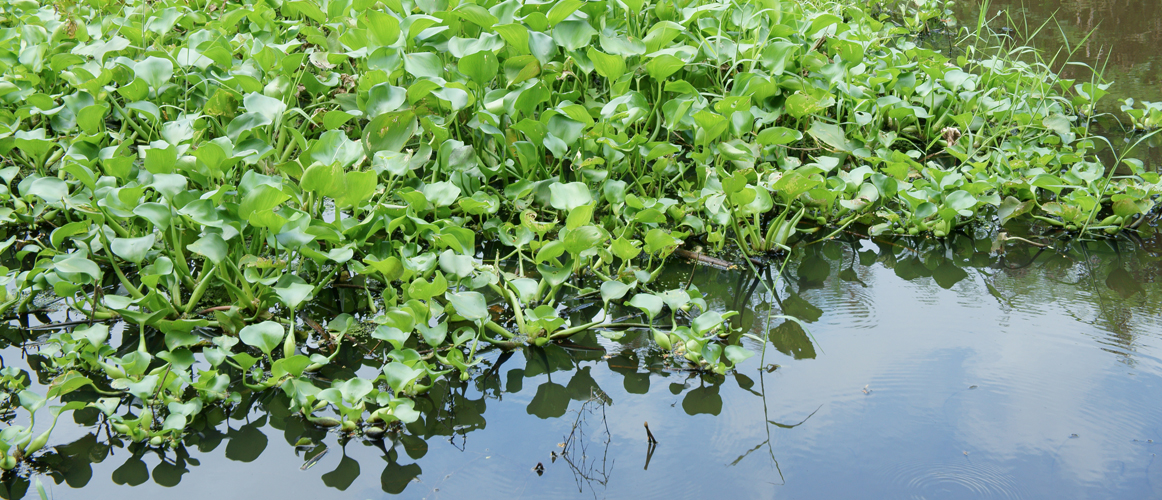Aquatic plants can enhance ponds on your golf course in multiple ways. But some are nuisance weeds that quickly take over, choking desirable plant life, slowing water movement, creating an overgrown look, or even turning your pond into a stagnant swamp.
Challenged with such an unsightly mess, you might look to herbicides that will quickly kill off plant life. However, using weed killers alone can kickstart a vicious cycle of regrowth and chemical dependency.
Instead, take a preventative approach to control aquatic weeds for good.
The Real Problem Is Nutrient Load
Aquatic weeds, like algae, will flourish in a pond that has a high nutrient load. Nutrients enter the water body from decaying organic matter such as fish waste, plant material, and fertilizer runoff. The nutrients are retained in the bottom muck and the water column.
Nutrients left unchecked will provide an excellent food source for both weeds and algae. And it’s your pond’s nutrient load that is the real problem—the weeds you see are the symptom.
If you choose to use a weed killer to eliminate existing vegetation, you must ensure the plant material isn’t left in the water to rot, otherwise it will create—you guessed it—more nutrients that fuel the growth of a new batch of weeds throughout your pond. Herbicides alone won’t stop weeds from reemerging.
Keeping Nutrients In Check
After attacking existing weeds through herbicidal or manual treatments, and removing the plant material completely from the pond, you can start a preventative approach to the underlying problem of excess nutrients.
To effectively and permanently lower your pond’s nutrient load, you want to fortify your pond with healthy beneficial bacteria. Beneficial bacteria feeds off of nutrients, as the weeds (and algae) do. A plentiful nutrient-hungry microbial population will compete with weeds for these nutrients. Eventually the bacteria consumes so much of the nutrient load that the weeds are starved out and struggle to grow.
Three Tools To Support Beneficial Bacteria
 |
|
A healthy pond at Hole 17 at Sun Lakes Country Club, CA. |
Aeration is a significant tool in the preventative approach. Because weeds grow faster in warmer water, aeration not only keeps water cool, but it increases the oxygen level in your pond as well. Oxygen is critical for aerobic (oxygen-using) microbes to quickly complete the process of consuming and converting nutrients so weeds stay in check. In helping the bacteria feed efficiently, oxygen prevents large bacterial die-offs which could otherwise result in a nutrient spike and trigger algae blooms and re-emergence of weeds.
Inoculation is another tool to consider. Inoculation introduces and maintains additional beneficial bacteria to attack your nutrient load. You may require a one-time jumpstart inoculation or an ongoing program of microbial top-ups.
Along with oxygenating your water and injecting microbes, you can support the potency of your beneficial bacteria by providing it with an environment to colonize. Beneficial bacteria requires a habitat in your pond for it to self-propagate, providing a continuous force of healthy microbes to devour nutrients as they enter the water column. Bacteria loves fine nooks and crannies, like in a gravelly bed or a manufactured nesting site, for it to develop over the long-term, sheltered from flushing events.
The Long-Term Solution
When you see pesky aquatic weeds, think beyond the plants to the source of the problem—your pond’s nutrient load. By supporting nutrient-hungry beneficial bacteria with aeration, inoculation, and habitats, you can get the upper hand on weeds for the long-term.
For more information, contact the Ewing Golf Team with questions about how to control aquatic weeds on your golf course.




